剑桥标准英语教程教(学)案
剑桥大学英语入门教学教案

课时:2课时年级:初学者教学目标:1. 让学生掌握英语字母表的基本知识。
2. 培养学生基本的英语听说读写能力。
3. 激发学生对英语学习的兴趣。
教学内容:1. 英语字母表2. 基本发音规则3. 简单的日常用语教学过程:第一课时:一、导入新课1. 教师播放一段英文歌曲,激发学生的学习兴趣。
2. 学生分享自己对英语学习的看法和期望。
二、学习英语字母表1. 教师展示字母表,讲解每个字母的发音和书写方法。
2. 学生跟读,教师纠正发音。
3. 学生尝试书写字母,教师检查并指导。
三、基本发音规则1. 教师讲解基本发音规则,如元音、辅音、重音等。
2. 学生练习发音,教师点评并指导。
四、课堂练习1. 学生分组进行字母表接龙游戏,巩固字母知识。
2. 学生互相询问对方的名字和年龄,使用所学日常用语。
五、总结与反馈1. 教师总结本节课所学内容,强调重点。
2. 学生分享学习心得,教师点评并给予鼓励。
第二课时:一、复习导入1. 教师带领学生回顾上节课所学内容,检查学习效果。
2. 学生分享自己在英语学习过程中的收获。
二、学习日常用语1. 教师讲解简单的日常用语,如问候、介绍、道别等。
2. 学生跟读,教师纠正发音。
三、课堂练习1. 学生分组进行角色扮演,模拟日常生活场景,使用所学日常用语。
2. 教师巡视指导,纠正发音和语法错误。
四、课堂游戏1. 学生进行“我说你做”游戏,巩固所学日常用语。
2. 教师点评并给予鼓励。
五、总结与反馈1. 教师总结本节课所学内容,强调重点。
2. 学生分享学习心得,教师点评并给予鼓励。
教学评价:1. 学生对英语字母表、基本发音规则和日常用语的掌握程度。
2. 学生在课堂练习和游戏中的参与度和表现。
3. 学生对英语学习的兴趣和积极性。
教学反思:1. 教师根据学生的学习情况,调整教学内容和教学方法。
2. 注重培养学生的听说读写能力,提高学生的英语综合素质。
3. 激发学生的学习兴趣,营造良好的英语学习氛围。
剑桥标准英语教程1级
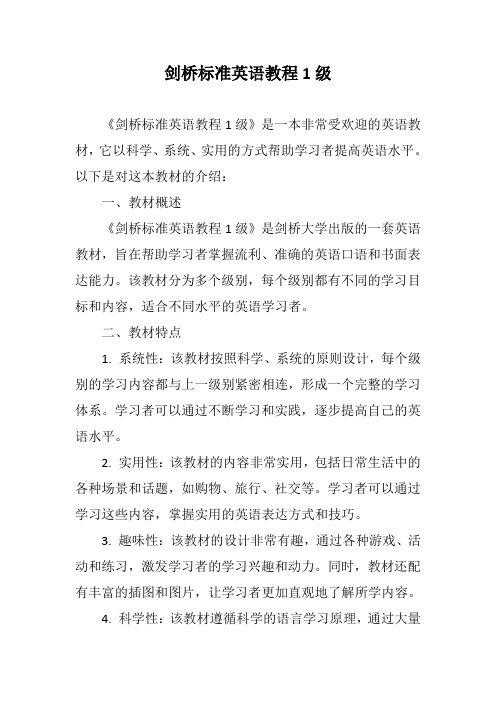
剑桥标准英语教程1级《剑桥标准英语教程1级》是一本非常受欢迎的英语教材,它以科学、系统、实用的方式帮助学习者提高英语水平。
以下是对这本教材的介绍:一、教材概述《剑桥标准英语教程1级》是剑桥大学出版的一套英语教材,旨在帮助学习者掌握流利、准确的英语口语和书面表达能力。
该教材分为多个级别,每个级别都有不同的学习目标和内容,适合不同水平的英语学习者。
二、教材特点1. 系统性:该教材按照科学、系统的原则设计,每个级别的学习内容都与上一级别紧密相连,形成一个完整的学习体系。
学习者可以通过不断学习和实践,逐步提高自己的英语水平。
2. 实用性:该教材的内容非常实用,包括日常生活中的各种场景和话题,如购物、旅行、社交等。
学习者可以通过学习这些内容,掌握实用的英语表达方式和技巧。
3. 趣味性:该教材的设计非常有趣,通过各种游戏、活动和练习,激发学习者的学习兴趣和动力。
同时,教材还配有丰富的插图和图片,让学习者更加直观地了解所学内容。
4. 科学性:该教材遵循科学的语言学习原理,通过大量的实践和练习,帮助学习者掌握英语的基本语法和词汇。
同时,教材还注重培养学习者的听、说、读、写能力,让学习者全面发展。
三、教材内容《剑桥标准英语教程1级》的内容主要包括以下几个方面:1. 语音:该教材注重语音训练,通过各种语音练习和活动,帮助学习者掌握正确的发音和语调。
2. 语法:该教材通过讲解和实践相结合的方式,帮助学习者掌握基本的英语语法规则和用法。
3. 词汇:该教材通过各种词汇练习和活动,帮助学习者扩大词汇量,提高词汇运用能力。
4. 听力:该教材通过各种听力练习和活动,帮助学习者提高听力理解能力。
5. 口语:该教材通过各种口语练习和活动,帮助学习者提高口语表达能力。
6. 阅读:该教材通过各种阅读练习和活动,帮助学习者提高阅读理解能力。
7. 写作:该教材通过各种写作练习和活动,帮助学习者提高写作表达能力。
四、适用人群《剑桥标准英语教程1级》适合初级英语学习者使用,特别是那些希望提高英语口语和书面表达能力的学习者。
剑桥国际英语教程5修订版教师用书
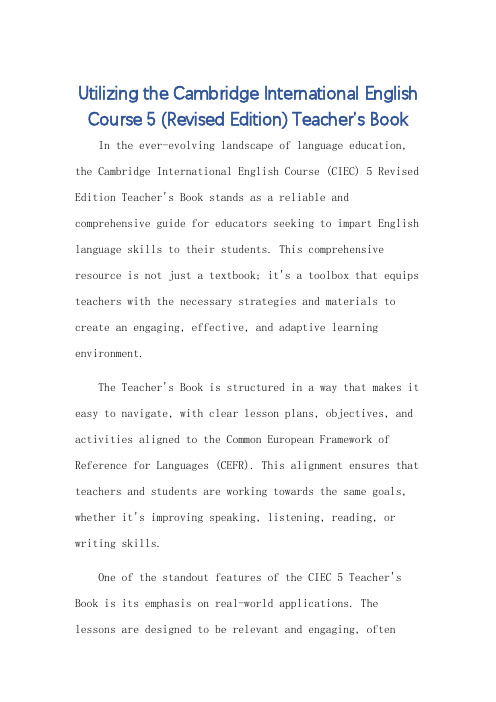
Utilizing the Cambridge International English Course 5 (Revised Edition) Teacher's Book In the ever-evolving landscape of language education, the Cambridge International English Course (CIEC) 5 Revised Edition Teacher's Book stands as a reliable and comprehensive guide for educators seeking to impart English language skills to their students. This comprehensive resource is not just a textbook; it's a toolbox that equips teachers with the necessary strategies and materials to create an engaging, effective, and adaptive learning environment.The Teacher's Book is structured in a way that makes it easy to navigate, with clear lesson plans, objectives, and activities aligned to the Common European Framework of Reference for Languages (CEFR). This alignment ensures that teachers and students are working towards the same goals, whether it's improving speaking, listening, reading, or writing skills.One of the standout features of the CIEC 5 Teacher's Book is its emphasis on real-world applications. The lessons are designed to be relevant and engaging, oftenincorporating real-life scenarios and contemporary topics that resonate with students. This approach not only makes learning more enjoyable but also more meaningful, as students can see how the language they are learning can be applied in real-world situations.Another noteworthy aspect is the focus ondifferentiated instruction. The Teacher's Book provides options and extensions for each lesson, allowing teachers to tailor the content to the needs and abilities of their students. This flexibility is crucial in today's diverse classrooms, where students come from different backgrounds and have varying levels of proficiency in English.The inclusion of a wealth of teaching resources, such as worksheets, activities, and games, further enhances the teacher's ability to create a dynamic and interactive learning environment. These resources are not just limited to the printed pages; they often include digital components that can be easily integrated into modern classrooms, taking advantage of technology to make learning more engaging and accessible.Moreover, the Teacher's Book emphasizes the importanceof assessment and provides guidance on how to effectively evaluate students' progress. With clear criteria and suggestions for formative and summative assessments, teachers can track their students' progress and identify areas where further support is needed.In conclusion, the Cambridge International English Course 5 Revised Edition Teacher's Book is an invaluable resource for any teacher looking to deliver high-quality English language instruction. It provides a solidfoundation in language skills, while also encouraging creativity and critical thinking. With its focus on real-world applications, differentiated instruction, and awealth of teaching resources, this Teacher's Book is amust-have for any educator seeking to enhance theirteaching practice and improve their students' language outcomes.**《剑桥国际英语教程5修订版教师用书》的应用** 在持续变化的语言教育领域中,《剑桥国际英语教程》(CIEC)5修订版教师用书作为一本可靠而全面的指南,为寻求向学生传授英语技能的教育工作者提供了有力的支持。
《Listening and speaking》 学历案
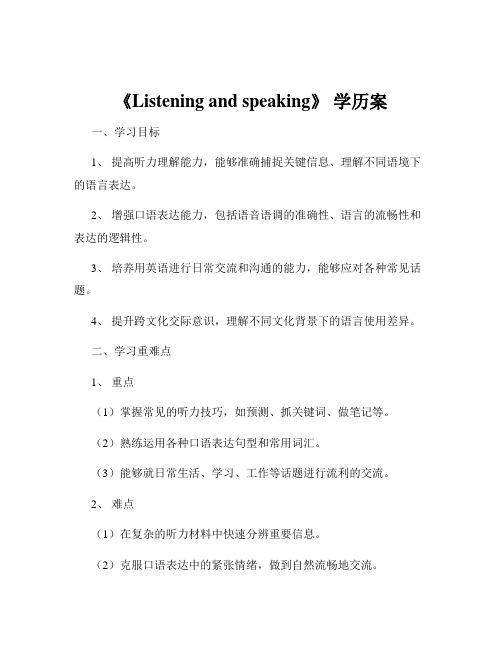
《Listening and speaking》学历案一、学习目标1、提高听力理解能力,能够准确捕捉关键信息、理解不同语境下的语言表达。
2、增强口语表达能力,包括语音语调的准确性、语言的流畅性和表达的逻辑性。
3、培养用英语进行日常交流和沟通的能力,能够应对各种常见话题。
4、提升跨文化交际意识,理解不同文化背景下的语言使用差异。
二、学习重难点1、重点(1)掌握常见的听力技巧,如预测、抓关键词、做笔记等。
(2)熟练运用各种口语表达句型和常用词汇。
(3)能够就日常生活、学习、工作等话题进行流利的交流。
2、难点(1)在复杂的听力材料中快速分辨重要信息。
(2)克服口语表达中的紧张情绪,做到自然流畅地交流。
(3)理解不同文化背景对语言交流的影响,并能在交流中灵活应对。
三、学习方法1、多听多模仿通过听英语广播、电影、歌曲等多种形式,模仿标准的语音语调,培养语感。
2、口语练习积极参与英语角、小组讨论、角色扮演等活动,增加开口说英语的机会。
3、记录与反思在听力和口语练习过程中,记录自己的错误和不足之处,及时反思并改进。
四、学习资源1、教材选用适合学习者水平的英语教材,如《新概念英语》《剑桥国际英语教程》等。
2、在线课程利用网络平台上的优质英语课程,如网易云课堂、腾讯课堂等。
3、英语学习 APP如百词斩、英语流利说等,辅助学习词汇和口语练习。
五、学习过程1、导入通过播放一段简单的英语对话或歌曲,引起学习者的兴趣,导入本节课的主题——Listening and speaking。
2、听力技巧讲解(1)预测根据题目或选项,对听力内容进行大致的猜测和预想。
例如,如果题目是关于旅行的,那么可能会涉及到目的地、交通工具、行程安排等方面的内容。
(2)抓关键词在听力过程中,注意捕捉关键的名词、动词、形容词等,这些往往是理解主要内容的关键。
比如,听到“weather”“hotel”“sightseeing”等词,就能大致判断出与旅行相关。
剑桥少儿国际英语上课教案
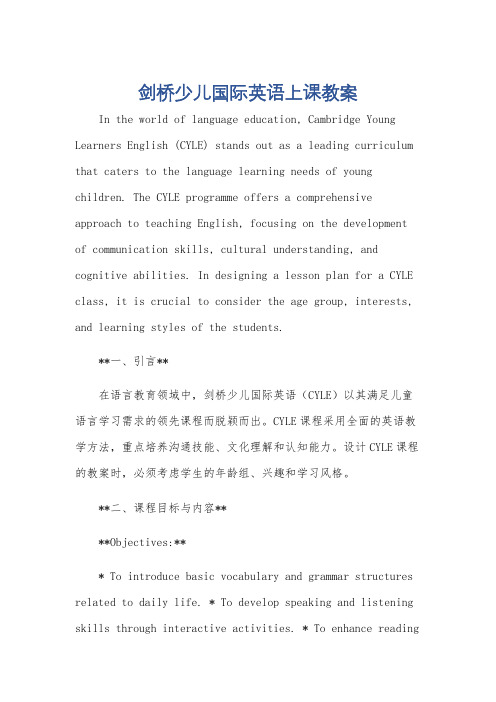
剑桥少儿国际英语上课教案In the world of language education, Cambridge Young Learners English (CYLE) stands out as a leading curriculum that caters to the language learning needs of young children. The CYLE programme offers a comprehensive approach to teaching English, focusing on the development of communication skills, cultural understanding, and cognitive abilities. In designing a lesson plan for a CYLE class, it is crucial to consider the age group, interests, and learning styles of the students.**一、引言**在语言教育领域中,剑桥少儿国际英语(CYLE)以其满足儿童语言学习需求的领先课程而脱颖而出。
CYLE课程采用全面的英语教学方法,重点培养沟通技能、文化理解和认知能力。
设计CYLE课程的教案时,必须考虑学生的年龄组、兴趣和学习风格。
**二、课程目标与内容****Objectives:*** To introduce basic vocabulary and grammar structures related to daily life. * To develop speaking and listening skills through interactive activities. * To enhance readingcomprehension with age-appropriate materials. * To foster cultural awareness and cross-cultural communication.**Content:*** Vocabulary: Daily routines, family members, school items, etc. * Grammar: Simple present tense, possessive adjectives, basic questions and answers. * Listening and speaking: Role-plays, storytelling, songs and rhymes. * Reading: Illustrated stories, picture dictionaries, and short texts. * Writing: Basic handwriting skills, writing simple sentences.**三、教学方法与活动****Methodology:*** Interactive teaching with games, activities, and real-life scenarios. * Use of visual aids, props, and multimedia resources. * Encouragement of student-centered learning and collaborative activities.**Activities:**1. **Warm-up:** A fun rhyme or song related to the topic to engage students' attention.2. **Vocabulary Introduction:** Illustrated cards or real objects tointroduce new vocabulary. 3. **Grammar Exploration:** Interactive board games or worksheets to practice grammar structures. 4. **Listening and Speaking Practice:** Role-plays or storytelling sessions with partner work. 5.**Reading Comprehension:** Illustrated stories followed by discussion questions. 6. **Writing Activity:** Tracing exercises and simple sentence writing with guidance. 7.**Cultural Awareness:** Discussion on cultural differences or cultural activities.**四、课堂管理与学生参与****Classroom Management:*** Creating a positive learning environment. * Managing student behavior and ensuring their engagement. * Providing individual attention and feedback to students.**Student Engagement:*** Encouraging active participation and collaboration. * Using激励机制to motivate students and recognize their achievements. * Providing opportunities for creative expression and critical thinking.**五、评估与反馈****Assessment:*** Ongoing formative assessments to monitor student progress. * End-of-term summative assessments to evaluate learning outcomes. * Observation of student participation and performance.**Feedback:*** Providing constructive feedback to students on their performance. * Encouraging self-assessment and peer review. * Using feedback to improve future lesson plans and teaching methods.**六、结语**Designing a lesson plan for a CYLE class is an exciting challenge that requires creativity, flexibility, and a deep understanding of the needs and abilities of young learners. By following the guidelines outlined in this article, teachers can create engaging and effective lessons that foster language development and cultural understanding among their students.**二、课程目标与内容****目标:*** 介绍与日常生活相关的基础词汇和语法结构。
剑桥规范标准英语教育教案课程教案
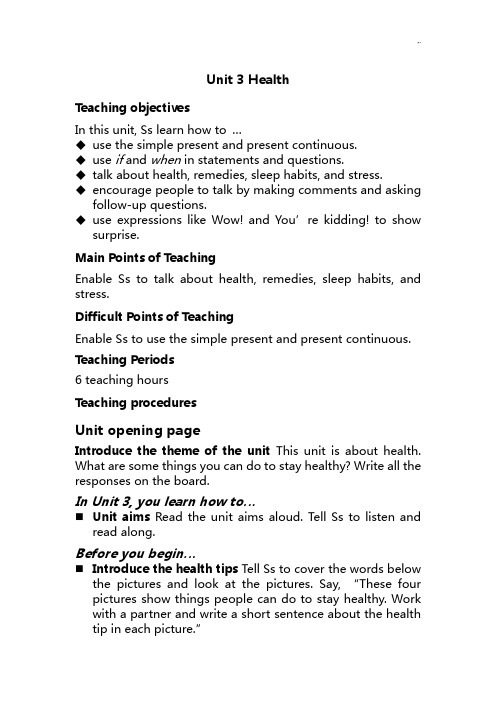
Unit 3 HealthTeaching objectivesIn this unit, Ss learn how to …◆use the simple present and present continuous.◆use if and when in statements and questions.◆talk about health, remedies, sleep habits, and stress.◆encourage people to talk by making comments and askingfollow-up questions.◆use expressions like Wow! and You’re kidding! to showsurprise.Main Points of TeachingEnable Ss to talk about health, remedies, sleep habits, and stress.Difficult Points of TeachingEnable Ss to use the simple present and present continuous. Teaching Periods6 teaching hoursTeaching proceduresUnit opening pageIntroduce the theme of the unit This unit is about health. What are some things you can do to stay healthy? Write all the responses on the board.In Unit 3, you learn how to…⏹Unit aims Read the unit aims aloud. Tell Ss to listen andread along.Before you begin…⏹Introduce the health tips Tell Ss to cover the words belowthe pictures and look at the pictures. Say, “These four pictures show things people can do to stay healthy. Work with a partner and write a short sentence about the health tip in each picture.”⏹Ask several pairs to share their tips with the class. Writetheir sentences on the board.⏹Read the sentences below the pictures aloud. Ss listen andrepeat. Help with new vocabulary as needed. Ss practice reading the sentences.⏹Ask the class, “Which of the things in the pictures do u doto stay healthy?”Have several Ss answer. Ask, “What else can u do? Use ideas from the board, or think of more things to do.”⏹Ss ask and answer in pairs. Then ask several Ss to reporttheir answers to the class.Lesson A Healthy living1 Getting started⏹Ste the scene Read the lesson title aloud. Ask, “What aresome things u do to stay healthy?”Ask a few Ss to answer.Ask, “Who is doing sth special, or different, to stay or get healthy right now?”Ask a few Ss to answer.A⏹Preview the task Read the instructions aloud.⏹Play the recording First, Ss read along. Then Ss listenwithout looking at books and write their answers.⏹Have Ss compare their answers in pairs. Check answers withthe class.B⏹Preview the task Say, “Read the interviews again. Look fortime words and expressions. Write these column headings on the board: Routines (All the time) and Temporary Events (Now). Ask a few Ss to call out the time expressions for the first headings, and write them on the board. Ask, “What verb tense do u see in the sentences with these time expressions?”⏹Ask a few Ss to call out the time expressions for the secondheading, and write them on the board. Ask, “What verb tense do u see in the sentences with these time expressions?”⏹Read the instructions aloud.⏹Do the task.⏹Have Ss compare their answers in pairs. Check answers withclass.2 Grammar⏹Present the grammar chart⏹Understand the grammar Say, “The grammar chartcompares the simple the simple present and the present continuous.”Explain that the simple present is used to talk about regular or repeated events or routines and situations are true all the time. And the present continuous is used for activities and events that are temporary, or going on around now. It is also used for activities that are going on at the time of speaking.⏹Present In Conversation Read the information aloud. HaveSs make a sentence in the simple present for each of the verbs presented.A⏹Preview the task Have Ss look at the picture. Ask, “What isshe doing?”Ask, “What is on the table?”(an aromatherapy burner) Read the instructions and the example aloud. Ask, “Why is the simple present the correct tense?”(It’s asking how u cope with stress in general or all the time.)⏹Do the task2 Listening and speakingA⏹Preview the task Say, “You will hear four people talkingabout their unhealthy habits. Read the incomplete statements and guess what each person says. Write your guesses.”⏹When Ss finish, ask a few Ss to call out their guesses foreach statement. Say, “Now listen and write what they actually say.”⏹Play the recording Ss listen and write the missing words.Check answers with the class.Lesson B Aches and pains1 Building vocabulary⏹Ste the scene Hold your head as if it hurts. Say, “I have aheadache.”Write a headache on the board. Hold your stomach as if it hurts. Say, “I have a stomachache.”Write it on the board. Ask, “What other health problems do u know the words for in English?”Write Ss’responses on the board.A⏹Preview the task Read the instructions aloud. Have SS lookat the pictures.⏹Play the recording Ss listen and repeat.⏹Ask, “Do u have any of these problems right now? If yes,raise your hand.”Ask any Ss who raise their hands, “Which problem do u have?”B⏹Preview the task Ask Ss to look at the chart. Read theinstructions aloud. Tell Ss to use ideas from the lists on the board or their own ideas.⏹Do the task2 Speaking naturallyA⏹Preview the task Have Ss look at the conversation. Say,“When people are speaking, they put stress on the words that are important in the sentence. An important word can be, for example, the answer to a question.”Say, “Stress is also used to contrast, or correct, information. For example, imagine I call u by the wrong name. When u correct me, u say your name clearly and a little more loudly.”⏹Read the instructions aloud.⏹Play the recording Ss listen and repeat.B⏹Preview the task Tell pairs to practice the conversation inPart A, taking turns playing each role. Read the instructions aloud.⏹Do the task3 Building language⏹Set the scene Write on the board: remedy. Explain, “Aremedy is used to fix a problem. For example, one remedyfor a headache is to take an aspirin. Imagine you have a cold. What remedy do u use?”Write Ss’responses on the board.A⏹Preview the task Look at the picture. Say, “Sonia and Markare talking on the phone. Where’s Mark?”(at home) “What’s wrong with her?”(He’s sick.) “What do u think Sonia and Mark are talking about?”(a remedy)⏹Books closed. Say, “What does Sonia want to make forMark? Listen and write the answer.”⏹Play the recording For the first time, Ss listen and write theanswer without looking at books; for the second time, Ss listen, read along, and review their answer. Then check the answer with the class⏹Practice the conversation in pairs.B⏹Preview the task Tell Ss to find if and when in theconversation and circle them. Ask, “What tense are the two verbs in each sentence?”⏹Do the task4 Grammar⏹Present the grammar chart⏹Understand the grammar Say, “When and if have verysimilar meanings. You can use when to talk about a situation that is usual for u, and u can use if to talk about a situation that is not so usual. But both are possible in the sentences in the chart.”A⏹Preview the task Read the instructions and the phrasesfrom No. 1 aloud. Read the example conversation. Remind Ss that they can put the part with when at the start of the sentence or after the other part. Have Ss complete the task.⏹Have Ss check answers in pairs. Then check answers withthe class.B⏹Preview and do the task.Lesson C How come you’re tired?1 Conversation strategy⏹Set the scene Read the title of the lesson aloud. Ask,“What does how come mean?”(why) Say, “Think about the title. Try to guess some of the words that are in the conversation in this lesson.”As Ss call out their guesses, write them on the board.A⏹Preview the task Tell Ss to look at A’s statement. Read italoud. Say, “Read B’s responses. Which are the best to keep the conversation going? Check the boxes.”Have Ss compare their answers in pairs. Check answers with the class.⏹Books closed. Read the instructions aloud.⏹Play the recording Books open. Ss listen and read along.⏹Play the recording again Ask, “Why is Adam tired?”Sslisten and write the answer.⏹Play the recording again Ss listen, read along, and reviewtheir answers. Check answers with the class.⏹Ask Ss to read the conversation again and circle any wordsthat they guessed would be in the conversation. As Ss call them out, circle them on the board.⏹Practice Have Ss practice the conversation in pairs.B⏹Preview the task Have Ss read the sentences and replies.⏹Do the taskC⏹Preview and do the task Read the instructions aloud. Tomodel the task, have two Ss read the example conversation.Have pairs use the sentences in Part B for ideas and give their own answers. Remind Ss to say more than just yes or no.2 Strategy plus⏹Find examples Say, “Look at the conversation on p.26again. Find the expressions that Yuki uses to show surprise.⏹Present Strategy plus Read the information and theexamples aloud. Ask, “Why does Yuki say ‘You’re kidding!’”⏹Present In Conversation Books closed. Write on the board:Oh, Wow, Really, and Gosh. Say, “Two of these are in the top 50 words, and two are in the top 500 words. Which two are in the top 50? Which two are in the top 500? Write your guesses.”Books open. Ask a S to read the information.Have Ss raise their hands if they guessed correctly.A⏹Preview the task Have Ss read the conversations. Say,“Now listen and write the expressions you hear.”⏹Play the recording Ss listen and read along. Listen againand write the expressions.⏹Check answers with the class.⏹Have Ss practice the conversation in pairs.B⏹Preview the task.⏹Play the recording Ss listen, then write the expression. Sslisten again. Then check answers with the class.3 Talk about it⏹Preview the task Read the instructions aloud. Ask Ss toread the discussion questions. Make sure that Ss understand the meaning of each question.⏹Do the task Have Ss discuss the questions in groups. Say,“When u find sth u have in common, make notes.”Lesson D Ways to relax1 Reading⏹Set the scene Read the title of the lesson aloud. Ask, “Howdo u relax? What do u do?”Get ideas from Ss.APrereading⏹Preview the task Write the word stressed on the board.Ask, “What does stressed mean?”Get ideas from Ss.⏹Do the taskBDuring reading⏹Preview the reading Have Ss look at the reading. Say,“This is a leaflet. A leaflet is usually one piece of paper with helpful information.”⏹Read the instructions aloud. Tell Ss to circle two new orinteresting things they learn as they read.⏹Do the reading Have Ss rend the leaflet and circle theinformation.⏹When Ss finish, call on a few Ss to tell the class theinformation they circled.⏹Do the reading again Have Ss read the leaflet again andunderline any new vocabulary. Help with new vocabulary as needed.CPostreading⏹Preview the task⏹Do the task Have Ss answer the questions and thencompare their answers pairs. Check answers with the class.2 Listening⏹Set the scene Tell Ss to look at the pictures. Ask, “Whereare the people? What are they doing?”Get ideas from Ss. A⏹Preview and do the task Read the instructions aloud. HaveSs work in pairs and discuss the questions⏹Call on several Ss to tell the class what they do to relax.B⏹Preview the task Read the instructions aloud.⏹Play the recording Play the first conversation. Ask, “Whichpicture does this conversation go with?”Then ask, “What words in the conversation help u choose this picture?”⏹Play the remaining conversations, and have Ss write theiranswers. Check answers with the class.C⏹Preview the task Read the instructions aloud.⏹Play the recording Play the first conversation, and thenpause the recording. Ask, “What else does she do to relax?”Ss write the answer under the picture they labeled1.⏹Play the remaining conversations. Ss listen and write theactivities.⏹Play the recording again Ss listen and review their answers.Check answers with the class.3 WritingA⏹Preview the task Ask some general questions aboutcommon health problems.⏹Read the instructions aloud. Call on four Ss to each read anexample.⏹Do the task Have Ss write a common health problem on apiece of paper.B⏹Preview the task Read the instructions aloud. Call ondifferent Ss to each read the example problem and the replies.⏹Present the Help note⏹Ask Ss to read some of the problems they wrote in Part A.Give suggestions using sentences with if when clauses.⏹Do the task Have Ss pass their papers around their group,and write a reply to each person.。
剑桥标准英语教程 教师用书
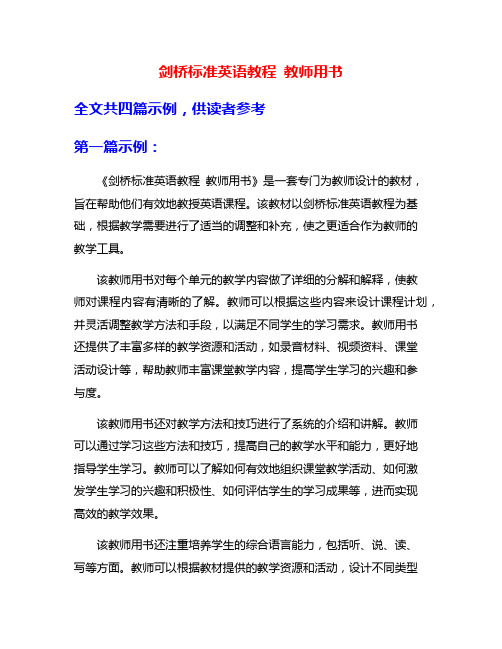
剑桥标准英语教程教师用书全文共四篇示例,供读者参考第一篇示例:《剑桥标准英语教程教师用书》是一套专门为教师设计的教材,旨在帮助他们有效地教授英语课程。
该教材以剑桥标准英语教程为基础,根据教学需要进行了适当的调整和补充,使之更适合作为教师的教学工具。
该教师用书对每个单元的教学内容做了详细的分解和解释,使教师对课程内容有清晰的了解。
教师可以根据这些内容来设计课程计划,并灵活调整教学方法和手段,以满足不同学生的学习需求。
教师用书还提供了丰富多样的教学资源和活动,如录音材料、视频资料、课堂活动设计等,帮助教师丰富课堂教学内容,提高学生学习的兴趣和参与度。
该教师用书还对教学方法和技巧进行了系统的介绍和讲解。
教师可以通过学习这些方法和技巧,提高自己的教学水平和能力,更好地指导学生学习。
教师可以了解如何有效地组织课堂教学活动、如何激发学生学习的兴趣和积极性、如何评估学生的学习成果等,进而实现高效的教学效果。
该教师用书还注重培养学生的综合语言能力,包括听、说、读、写等方面。
教师可以根据教材提供的教学资源和活动,设计不同类型的教学内容,帮助学生全面提高语言能力。
通过多样化的课堂活动和练习,学生可以更全面、更系统地掌握语言知识和运用能力,从而更好地应对日常生活和学习需求。
在教学实践中,教师用书还注重培养学生的学习策略和自主学习能力。
教师可以通过设计启发性的教学活动,引导学生主动思考、自主学习,从而培养他们的学习兴趣和自主学习能力。
教师还可以根据学生的学习情况和需要,调整和改进自己的教学方法和手段,以更好地满足学生的学习需求。
《剑桥标准英语教程教师用书》是一本优秀的教学工具,可以帮助教师更好地组织和指导英语课程,提高学生的语言能力和综合素质。
教师可以通过学习和应用该教师用书,不断提升自己的教学水平和能力,为学生的学习和成长做出更大的贡献。
希望更多的教师能够利用这本教师用书,开展更富有成效的英语教学工作。
第二篇示例:剑桥标准英语教程(Cambridge English: Standard Course Teacher's Book)是一本针对中级水平学生设计的全面英语教材。
剑桥英语教案高中模板
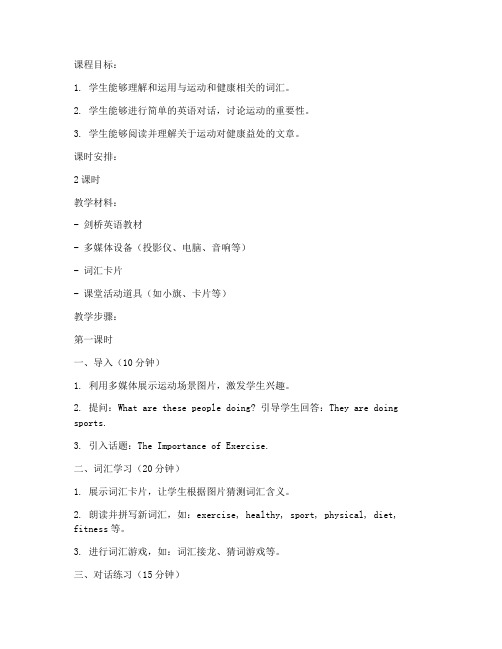
课程目标:1. 学生能够理解和运用与运动和健康相关的词汇。
2. 学生能够进行简单的英语对话,讨论运动的重要性。
3. 学生能够阅读并理解关于运动对健康益处的文章。
课时安排:2课时教学材料:- 剑桥英语教材- 多媒体设备(投影仪、电脑、音响等)- 词汇卡片- 课堂活动道具(如小旗、卡片等)教学步骤:第一课时一、导入(10分钟)1. 利用多媒体展示运动场景图片,激发学生兴趣。
2. 提问:What are these people doing? 引导学生回答:They are doing sports.3. 引入话题:The Importance of Exercise.二、词汇学习(20分钟)1. 展示词汇卡片,让学生根据图片猜测词汇含义。
2. 朗读并拼写新词汇,如:exercise, healthy, sport, physical, diet, fitness等。
3. 进行词汇游戏,如:词汇接龙、猜词游戏等。
三、对话练习(15分钟)1. 分组进行角色扮演,模拟日常对话场景,如:询问对方是否喜欢运动、讨论运动的好处等。
2. 教师巡回指导,纠正发音和语法错误。
四、课堂小结(5分钟)1. 总结本节课所学新词汇和对话内容。
2. 布置课后作业。
第二课时一、复习导入(10分钟)1. 回顾上节课所学内容,检查学生掌握情况。
2. 展示运动场景图片,让学生用英语描述。
二、阅读理解(20分钟)1. 分发课文,让学生阅读并回答问题。
2. 讨论课文内容,如:运动对健康的益处、如何保持健康等。
3. 教师总结课文重点,并解释生词和短语。
三、课堂活动(15分钟)1. 进行小组讨论,让学生分享自己最喜欢的运动。
2. 每组选派代表进行展示,其他组进行评价。
四、课堂小结(5分钟)1. 总结本节课所学内容,强调运动对健康的重要性。
2. 布置课后作业。
教学评价:1. 观察学生在课堂上的参与度和表现,如:回答问题、参与活动等。
2. 检查学生的作业完成情况,如:词汇卡片、课文阅读理解等。
ket的学习计划
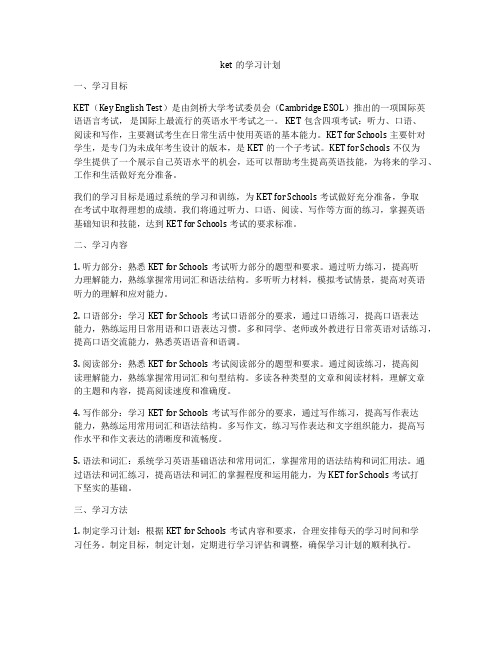
ket的学习计划一、学习目标KET(Key English Test)是由剑桥大学考试委员会(Cambridge ESOL)推出的一项国际英语语言考试,是国际上最流行的英语水平考试之一。
KET包含四项考试:听力、口语、阅读和写作,主要测试考生在日常生活中使用英语的基本能力。
KET for Schools主要针对学生,是专门为未成年考生设计的版本,是KET的一个子考试。
KET for Schools不仅为学生提供了一个展示自己英语水平的机会,还可以帮助考生提高英语技能,为将来的学习、工作和生活做好充分准备。
我们的学习目标是通过系统的学习和训练,为KET for Schools考试做好充分准备,争取在考试中取得理想的成绩。
我们将通过听力、口语、阅读、写作等方面的练习,掌握英语基础知识和技能,达到KET for Schools考试的要求标准。
二、学习内容1. 听力部分:熟悉KET for Schools考试听力部分的题型和要求。
通过听力练习,提高听力理解能力,熟练掌握常用词汇和语法结构。
多听听力材料,模拟考试情景,提高对英语听力的理解和应对能力。
2. 口语部分:学习KET for Schools考试口语部分的要求,通过口语练习,提高口语表达能力,熟练运用日常用语和口语表达习惯。
多和同学、老师或外教进行日常英语对话练习,提高口语交流能力,熟悉英语语音和语调。
3. 阅读部分:熟悉KET for Schools考试阅读部分的题型和要求。
通过阅读练习,提高阅读理解能力,熟练掌握常用词汇和句型结构。
多读各种类型的文章和阅读材料,理解文章的主题和内容,提高阅读速度和准确度。
4. 写作部分:学习KET for Schools考试写作部分的要求,通过写作练习,提高写作表达能力,熟练运用常用词汇和语法结构。
多写作文,练习写作表达和文字组织能力,提高写作水平和作文表达的清晰度和流畅度。
5. 语法和词汇:系统学习英语基础语法和常用词汇,掌握常用的语法结构和词汇用法。
剑桥英语示范教案(5篇)
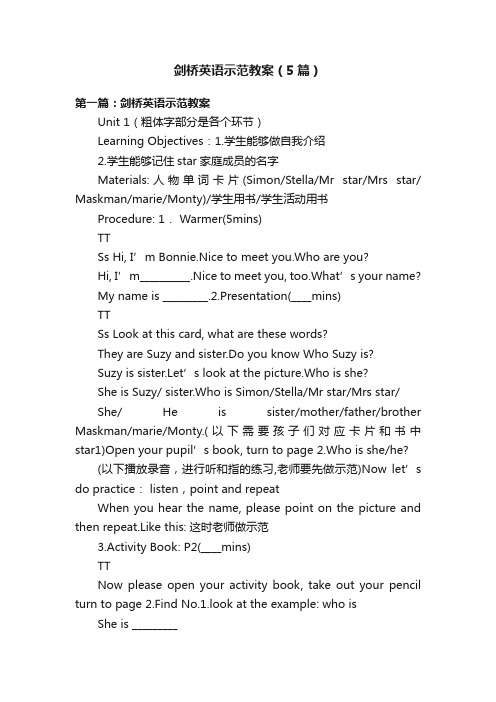
剑桥英语示范教案(5篇)第一篇:剑桥英语示范教案Unit 1(粗体字部分是各个环节)Learning Objectives:1.学生能够做自我介绍2.学生能够记住star家庭成员的名字Materials:人物单词卡片(Simon/Stella/Mr star/Mrs star/ Maskman/marie/Monty)/学生用书/学生活动用书Procedure: 1. Warmer(5mins)TTSs Hi, I’m Bonnie.Nice to meet you.Who are you?Hi, I’m__________.Nice to meet you, too.What’s your name?My name is _________.2.Presentation(____mins)TTSs Look at this card, what are these words?They are Suzy and sister.Do you know Who Suzy is?Suzy is sister.Let’s look at the picture.Who is she?She is Suzy/ sister.Who is Simon/Stella/Mr star/Mrs star/She/ He is sister/mother/father/brother Maskman/marie/Monty.(以下需要孩子们对应卡片和书中star1)Open your pupil’s book, turn to page 2.Who is she/he?(以下播放录音,进行听和指的练习,老师要先做示范)Now let’s do practice: listen,point and repeatWhen you hear the name, please point on the picture and then repeat.Like this: 这时老师做示范3.Activity Book: P2(____mins)TTNow please open your activity book, take out your pencil turn to page 2.Find No.1.look at the example: who is She is _________Mr star/ Mrs star``````Ssshe is Suzy,she? Now we should find the shadow of Suzy, and then draw a line to link them.When you finish, you should exchange your book with yourShe/he is _____ partner, and then check the work.(老师同样这时要做示范告诉孩子如何做)Did you see star 2? Let’s listen and circle the tick or cross,Look here, this is Marie, yes or no?So we use cross ╳to represent noThis is Simon, yes or no?So we use tick to represent yes√No we will listen to the video and then circle the tick and cross Are you ready? When you finished, please exchange your book, check your answer Who is she/he?No, This is Simon.yes!学生要大声说出答案And tell me the right answer.4.Games(______mins)TT It’s game ti me, everyone stand up, let’s stand in a circle.your name.I have a ball, I should say :I’m Bonnie and then I throw my ball to Lisa, I need ask lisa: what’s your name? Lisa hold the ball and answer my question, after that she needs to throw the ball to others.The person who holds the ball should tell us your name and say what’s your name?5.Ending(_____mins)TTLet’s review what we learned today, who is she/he?I’m Lisa, what’s SsShe /he is _______Please say good bye to Mr star```````good bye , Mr star 6.Homework 课后反思:今天上课的优点1.2.3.不足及提升方案:1.2.第二篇:剑桥英语剑桥少儿英语预备级上册unit1详细教案Unit1 Greetings一.课文地位:作为教材的第一课,对学生培养学习兴趣有很重要的作用。
剑桥国际少儿英语一年级单元教案

教案标题:Unit 1 - My Family教学课时:5课时教学目标:1.学习家庭成员的英文表达,如爸爸、妈妈、哥哥、姐姐、弟弟和妹妹。
2. 学习使用英文表达家庭成员的称呼,如“This is my dad.”3. 学习描述家庭成员的外貌特征,如“He is tall.”、“She has long hair.”4. 学习用英文表达家庭成员之间的关系,如“My brother is my father's son.”5.练习用英文自我介绍并描述家庭成员。
教学准备:1.小黑板及粉笔/白板及马克笔2. 单词卡片:dad, mom, brother, sister, son, daughter, tall, short, long hair3.教材:剑桥国际少儿英语一年级教材第一课到第五课4.学生练习册教学步骤:Step 1:任务呈现(10分钟)a.教师出示图片,引导学生用汉语表达家庭成员的称谓(爸爸、妈妈、哥哥、姐姐、弟弟和妹妹)。
b.教师出示单词卡片,逐个介绍并示范正确的发音,并让学生跟读。
c.让学生尝试用英文表达家庭成员的称谓。
Step 2:课文导入(15分钟)a.教师播放课文录音,学生跟读。
b.教师以口头问答的形式与学生互动,引导学生回答有关课文的问题。
c.学生小组合作,分角色模仿课文对话,并试着自己编写类似的对话。
Step 3:课文拓展(15分钟)a.学生阅读课文,并找出课文中的关键词。
b.学生分组合作,根据关键词和课文内容编写简单的短文。
c.每组派一名代表进行展示,并互相点评。
Step 4:生活应用(15分钟)a.教师出示图片,让学生描述家庭成员的外貌特征,如身高、发型等。
b.学生小组合作,练习描述家庭成员的外貌特征,并互相猜测对方所描述的家庭成员是谁。
Step 5:自我介绍(20分钟)a.学生个别练习,用英文进行自我介绍,并描述自己的家庭成员。
b.学生两两搭档,进行互相介绍,并描述对方的家庭成员。
剑桥版英语备课教案
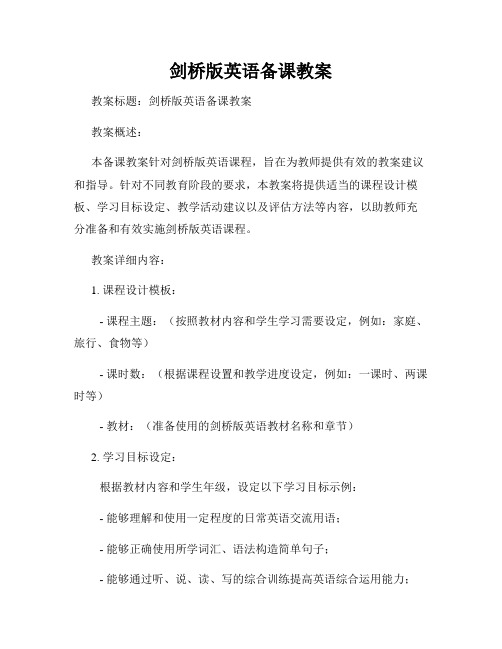
剑桥版英语备课教案教案标题:剑桥版英语备课教案教案概述:本备课教案针对剑桥版英语课程,旨在为教师提供有效的教案建议和指导。
针对不同教育阶段的要求,本教案将提供适当的课程设计模板、学习目标设定、教学活动建议以及评估方法等内容,以助教师充分准备和有效实施剑桥版英语课程。
教案详细内容:1. 课程设计模板:- 课程主题:(按照教材内容和学生学习需要设定,例如:家庭、旅行、食物等)- 课时数:(根据课程设置和教学进度设定,例如:一课时、两课时等)- 教材:(准备使用的剑桥版英语教材名称和章节)2. 学习目标设定:根据教材内容和学生年级,设定以下学习目标示例:- 能够理解和使用一定程度的日常英语交流用语;- 能够正确使用所学词汇、语法构造简单句子;- 能够通过听、说、读、写的综合训练提高英语综合运用能力;- 能够积极参与课堂活动,培养英语学习的兴趣和自信心。
3. 教学活动建议:为了实现学习目标,以下列举一些教学活动建议:- 听力练习:通过听录音和教师口语表达,学生能够提高听力理解能力;- 口语训练:通过对话、角色扮演等活动,激发学生的口语表达能力;- 阅读理解:通过阅读教材中的文章、短文等,培养学生的阅读理解能力;- 书写练习:通过书写单词、句子等,巩固所学内容;- 小组合作:通过小组合作活动,促进学生之间的互动和协作能力。
4. 评估方法:为了评估学生的学习效果,可以采用以下评估方法:- 课堂参与度评估:根据学生在课堂上表现的积极参与程度进行评估;- 作业评价:根据作业完成情况和质量评估学生的学习情况;- 测验或考试:通过定期的测验或考试评估学生对所学知识的掌握程度;- 口语表达评估:通过对学生口语表达的听力评估学生的口语能力。
总结:本备课教案提供了针对剑桥版英语课程的教案建议和指导。
教师可以根据实际情况和学生的学习需要,适当调整和修改教案内容,以确保教学效果和学生学习成果的提高。
同时,教师可以根据该教案的框架,进一步设计和编写具体的教案,以满足教学的个性化需求。
《剑桥国际英语教程》教学标准剑一上

Unit1 Please call me Beth.Cycle1—Part1-5�主题:介绍自己和他人以及相互问候。
�主要语法:be 动词的用法和形容词性物主代词。
�功能项:(1)向初次见面的朋友介绍自己,例如:姓名,外貌特征,来自的国家(2)形容词性物主代词和名词性物主代词的区别使用�目标词汇:四会单词:听、说、写、用;三会单词:听、说、用;拓展单词:基本了解,难点提前预知。
�【part 5】目标语法:系动词be 用法。
例句分析:一.系动词 be 的用法例句1.I am a girl=I'm a girl2.You are a girl=You're a girl.3.He is a boy.=He's a boy.4.She is a girl.=She's a girl.5.It is a tree.=It's a tree.6.We are students.=We're students.7.They are students=They're students.练习题:1.I from China.2.He from America.3.My name Helen.二.形容词性物主代词例句1.Our teacher is coming.2.My mom is a teacher.3.Your mom is a doctor.练习题:1. sister is a student.2. name is Silva.3.Where is book? I can't find it.三.特殊疑问句例句1.What do you do?2.Where is ShanDong University?3.Which book is yours?练习题:1. is your home?2. is your name?3. pen is it?课堂流程各部分时间分配:(110 分钟课时量)本单元世界之窗(文化):Seoul:是大韩民国的首都,也是韩国最大的城市。
剑桥国际英语教程入门级单元全PPT学习教案
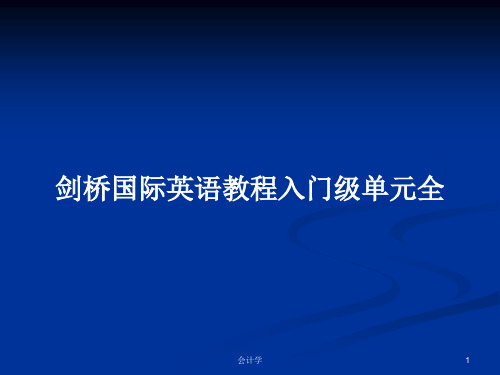
P: Great! Our clothes are dry. Where is my new blouse? J: What color is it? P: it’s white. J: Here’s a light blue blouse. Is it yours? P: No, it’s not mine---Wait. It is mine. It’s a disaster! J: Oh, no. All our clothes are light blue. P: Here’s the problem. It’s these new blue jeans. Whose jeans are they? J: Uh, they’re mine. Sorry.
我问她但她不回答。 It‘s asking for trouble.
这是自找苦吃。 We asked him to dinner.
我们请他吃饭。
第9页/共18页
重点单词
favorite adj. 最喜爱的;n.喜欢的事物 What are your favorite sports/colors? 你喜爱的运动/颜色是什么? Who is your favorite TV star/singer? ? 谁是你最喜爱的电视明星/歌手? Fruit and vegetables are my favorite. 蔬菜水果是我最喜爱的食物。
蓝色 紫色 灰色 白色 棕色 黑色 浅棕色 深棕色
第7页/共18页
dry wet yours mine hers whose
其他
干的 湿的 你的 我的 她的 谁的
第8页/共18页
重点单词
ask vt. 问,询问;要求 ;邀请 I asked her but she didn‘t answer.
剑桥国际英语入门版Unit 2教案

Unit 2 What’s this?一、Procedures:1.复习2.复习之后可以教学生一些身边的常用物品的说法。
例如,可以让学生拿出自己的包,然后教他们自己包里的东西用英语怎么说。
3.Snapshot1)把书合上,把online shopping的单词写到黑板上,跟学生假设为了出门旅行进行网上购物,然后把单词逐个讲解,并且问学生这个自己的包里有么?把有的和没有的区分开来,并让学生记住单词。
2)然后让学生分成组,相互询问对方的包里有什么。
4.Articles1)将教室里的物品的说法告诉学生。
2)将我们之前讲过的单词总结到一起,让学生记住。
3)为学生讲解,有些单词是元音字母开头,有些单词是非元音字母开头,在元音字母开头的单词前用的是不定冠词a,在非元音字母开头的单词前用的是不定冠词an。
4)让学生重新看这些黑板上总结过的单词,并让其分辨出那些单词用a,那些单词用an。
5)指着教室里的某样物品问What’s this?并且教给学生应该回答This is…然后再问学生How to spell …?然后学生回答。
6)以这种形式为基础,让学生们进行角色扮演。
5.Conversation1)假设一个生日聚会的场景,跟助教老师一起表演送生日礼物的对话,事实上就是表演书上的那一段对话。
2)以这种形式为基础,让学生们进行角色扮演。
主要可以运用今天所学的单词。
6.Pronunciation1)从今天学习的单词入手,引导学生学习这些单词的复数的不同念法。
再加一些关于单词中的s发音不同的典型单词。
例如pens读/z/,books读/s/,sunglasses读/iz/。
2)打开书看B,让学生们学习这些单词的发音并且填到表格中,填完之后相互交换检查。
7.Grammar focus1)告诉学生我们这节课主要就是学习what’s this,把大标题写在黑板上。
2)告诉学生these are,they are和复数的用法。
剑桥标准英语教程2a
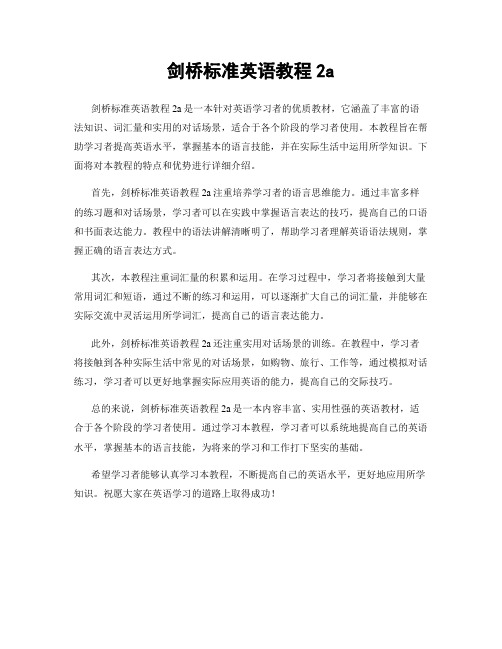
剑桥标准英语教程2a
剑桥标准英语教程2a是一本针对英语学习者的优质教材,它涵盖了丰富的语法知识、词汇量和实用的对话场景,适合于各个阶段的学习者使用。
本教程旨在帮助学习者提高英语水平,掌握基本的语言技能,并在实际生活中运用所学知识。
下面将对本教程的特点和优势进行详细介绍。
首先,剑桥标准英语教程2a注重培养学习者的语言思维能力。
通过丰富多样的练习题和对话场景,学习者可以在实践中掌握语言表达的技巧,提高自己的口语和书面表达能力。
教程中的语法讲解清晰明了,帮助学习者理解英语语法规则,掌握正确的语言表达方式。
其次,本教程注重词汇量的积累和运用。
在学习过程中,学习者将接触到大量常用词汇和短语,通过不断的练习和运用,可以逐渐扩大自己的词汇量,并能够在实际交流中灵活运用所学词汇,提高自己的语言表达能力。
此外,剑桥标准英语教程2a还注重实用对话场景的训练。
在教程中,学习者将接触到各种实际生活中常见的对话场景,如购物、旅行、工作等,通过模拟对话练习,学习者可以更好地掌握实际应用英语的能力,提高自己的交际技巧。
总的来说,剑桥标准英语教程2a是一本内容丰富、实用性强的英语教材,适合于各个阶段的学习者使用。
通过学习本教程,学习者可以系统地提高自己的英语水平,掌握基本的语言技能,为将来的学习和工作打下坚实的基础。
希望学习者能够认真学习本教程,不断提高自己的英语水平,更好地应用所学知识。
祝愿大家在英语学习的道路上取得成功!。
剑桥标准英语教程好吗
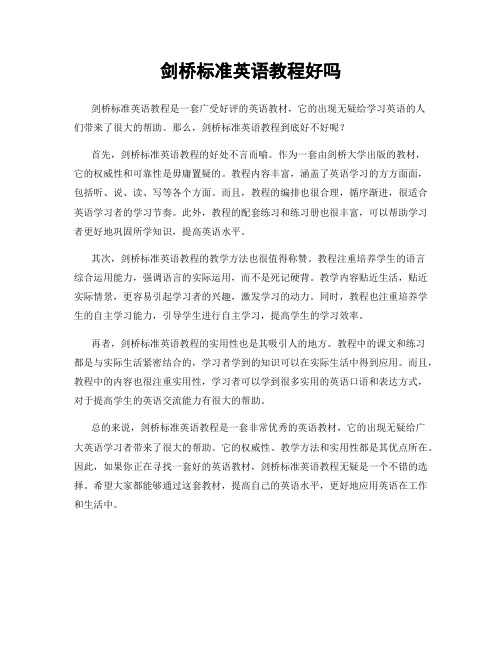
剑桥标准英语教程好吗
剑桥标准英语教程是一套广受好评的英语教材,它的出现无疑给学习英语的人
们带来了很大的帮助。
那么,剑桥标准英语教程到底好不好呢?
首先,剑桥标准英语教程的好处不言而喻。
作为一套由剑桥大学出版的教材,
它的权威性和可靠性是毋庸置疑的。
教程内容丰富,涵盖了英语学习的方方面面,包括听、说、读、写等各个方面。
而且,教程的编排也很合理,循序渐进,很适合英语学习者的学习节奏。
此外,教程的配套练习和练习册也很丰富,可以帮助学习者更好地巩固所学知识,提高英语水平。
其次,剑桥标准英语教程的教学方法也很值得称赞。
教程注重培养学生的语言
综合运用能力,强调语言的实际运用,而不是死记硬背。
教学内容贴近生活,贴近实际情景,更容易引起学习者的兴趣,激发学习的动力。
同时,教程也注重培养学生的自主学习能力,引导学生进行自主学习,提高学生的学习效率。
再者,剑桥标准英语教程的实用性也是其吸引人的地方。
教程中的课文和练习
都是与实际生活紧密结合的,学习者学到的知识可以在实际生活中得到应用。
而且,教程中的内容也很注重实用性,学习者可以学到很多实用的英语口语和表达方式,对于提高学生的英语交流能力有很大的帮助。
总的来说,剑桥标准英语教程是一套非常优秀的英语教材,它的出现无疑给广
大英语学习者带来了很大的帮助。
它的权威性、教学方法和实用性都是其优点所在。
因此,如果你正在寻找一套好的英语教材,剑桥标准英语教程无疑是一个不错的选择。
希望大家都能够通过这套教材,提高自己的英语水平,更好地应用英语在工作和生活中。
剑桥标准英语教程和剑桥国际英语教程
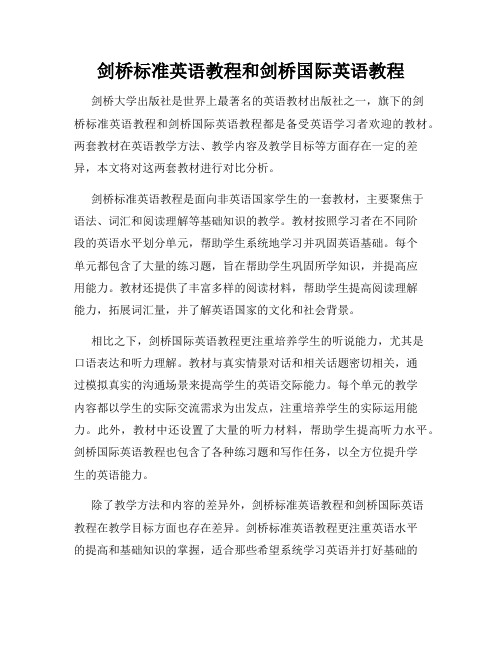
剑桥标准英语教程和剑桥国际英语教程剑桥大学出版社是世界上最著名的英语教材出版社之一,旗下的剑桥标准英语教程和剑桥国际英语教程都是备受英语学习者欢迎的教材。
两套教材在英语教学方法、教学内容及教学目标等方面存在一定的差异,本文将对这两套教材进行对比分析。
剑桥标准英语教程是面向非英语国家学生的一套教材,主要聚焦于语法、词汇和阅读理解等基础知识的教学。
教材按照学习者在不同阶段的英语水平划分单元,帮助学生系统地学习并巩固英语基础。
每个单元都包含了大量的练习题,旨在帮助学生巩固所学知识,并提高应用能力。
教材还提供了丰富多样的阅读材料,帮助学生提高阅读理解能力,拓展词汇量,并了解英语国家的文化和社会背景。
相比之下,剑桥国际英语教程更注重培养学生的听说能力,尤其是口语表达和听力理解。
教材与真实情景对话和相关话题密切相关,通过模拟真实的沟通场景来提高学生的英语交际能力。
每个单元的教学内容都以学生的实际交流需求为出发点,注重培养学生的实际运用能力。
此外,教材中还设置了大量的听力材料,帮助学生提高听力水平。
剑桥国际英语教程也包含了各种练习题和写作任务,以全方位提升学生的英语能力。
除了教学方法和内容的差异外,剑桥标准英语教程和剑桥国际英语教程在教学目标方面也存在差异。
剑桥标准英语教程更注重英语水平的提高和基础知识的掌握,适合那些希望系统学习英语并打好基础的学生。
而剑桥国际英语教程则更注重实际交际能力的培养,适合那些希望能够流利运用英语进行国际交流的学生。
总体而言,剑桥标准英语教程和剑桥国际英语教程都是优秀的英语教材,各自侧重不同,满足了不同学生的需求。
学习者可以根据自己的学习目标和英语水平选择合适的教材进行学习。
同时,教师也应根据学生的实际情况和需求,合理选用教材,并根据教材提供的教学资源和活动设计灵活教学,提高教学效果。
总结一下,剑桥标准英语教程和剑桥国际英语教程在教学方法、内容和目标等方面存在差异,但都是高质量的英语教材。
- 1、下载文档前请自行甄别文档内容的完整性,平台不提供额外的编辑、内容补充、找答案等附加服务。
- 2、"仅部分预览"的文档,不可在线预览部分如存在完整性等问题,可反馈申请退款(可完整预览的文档不适用该条件!)。
- 3、如文档侵犯您的权益,请联系客服反馈,我们会尽快为您处理(人工客服工作时间:9:00-18:30)。
Unit 3 HealthTeaching objectivesIn this unit, Ss learn how to …◆use the simple present and present continuous.◆use if and when in statements and questions.◆talk about health, remedies, sleep habits, and stress.◆encourage people to talk by making comments and askingfollow-up questions.◆use expressions like Wow! and You’re kidding! to showsurprise.Main Points of TeachingEnable Ss to talk about health, remedies, sleep habits, and stress.Difficult Points of TeachingEnable Ss to use the simple present and present continuous. Teaching Periods6 teaching hoursTeaching proceduresUnit opening pageIntroduce the theme of the unit This unit is about health. What are some things you can do to stay healthy? Write all the responses on the board.In Unit 3, you learn how to…⏹Unit aims Read the unit aims aloud. Tell Ss to listen andread along.Before you begin…⏹Introduce the health tips Tell Ss to cover the words belowthe pictures and look at the pictures. Say, “These four pictures show things people can do to stay healthy. Work with a partner and write a short sentence about the health tip in each picture.”⏹Ask several pairs to share their tips with the class. Writetheir sentences on the board.⏹Read the sentences below the pictures aloud. Ss listenand repeat. Help with new vocabulary as needed. Ss practice reading the sentences.⏹Ask the class, “Which of the things in the pictures do udo to stay healthy?” Have several Ss answer. Ask, “What else can u do? Use ideas from the board, or think of more things to do.”⏹Ss ask and answer in pairs. Then ask several Ss to reporttheir answers to the class.Lesson A Healthy living1 Getting started⏹Ste the scene Read the lesson title aloud. Ask, “What aresome things u do to stay healthy?”Ask a few Ss to answer. Ask, “Who is doing sth special, or different, to stay or get healthy right now?” Ask a few Ss to answer. A⏹Preview the task Read the instructions aloud.⏹Play the recording First, Ss read along. Then Ss listenwithout looking at books and write their answers.⏹Have Ss compare their answers in pairs. Check answerswith the class.B⏹Preview the task Say, “Read the interviews again. Lookfor time words and expressions. Write these column headings on the board: Routines (All the time)and Temporary Events (Now). Ask a few Ss to call out the timeexpressions for the first headings, and write them on the board. Ask, “What verb tense do u see in the sentences with these time expressions?”⏹Ask a few Ss to call out the time expressions for thesecond heading, and write them on the board. Ask, “What verb tense do u see in the sentences with these time expressions?”⏹Read the instructions aloud.⏹Do the task.⏹Have Ss compare their answers in pairs. Check answerswith class.2 Grammar⏹Present the grammar chart⏹Understand the grammar Say, “The grammar chartcompares the simple the simple present and the present continuous.” Explain that the simple present is used to talk about regular or repeated events or routines and situations are true all the time. And the present continuous is used for activities and events that are temporary, or going on around now. It is also used for activities that are going on at the time of speaking.⏹Present In Conversation Read the information aloud. HaveSs make a sentence in the simple present for each of the verbs presented.A⏹Preview the task Have Ss look at the picture. Ask, “Whatis she doing?”Ask, “What is on the table?”(an aromatherapy burner) Read the instructions and the example aloud. Ask, “Why is the simple present the correct tense?”(It’s asking how u cope with stress in general or all the time.)⏹Do the task2 Listening and speakingA⏹Preview the task Say, “You will hear four people talkingabout their unhealthy habits. Read the incomplete statements and guess what each person says. Write your guesses.”⏹When Ss finish, ask a few Ss to call out their guesses foreach statement. Say, “Now listen and write what they actually say.”⏹Play the recording Ss listen and write the missing words.Check answers with the class.Lesson B Aches and pains1 Building vocabulary⏹Ste the scene Hold your head as if it hurts. Say, “I have aheadache.”Write a headache on the board. Hold your stomach as if it hurts. Say, “I have a stomachache.”Write it on the board. Ask, “What other health problems do u know the words for in English?”Write Ss’responses on the board.A⏹Preview the task Read the instructions aloud. Have SSlook at the pictures.⏹Play the recording Ss listen and repeat.⏹Ask, “Do u have any of these problems right now? If yes,raise your hand.”Ask any Ss who raise their hands, “Which problem do u have?”B⏹Preview the task Ask Ss to look at the chart. Read theinstructions aloud. Tell Ss to use ideas from the lists on the board or their own ideas.⏹Do the task2 Speaking naturallyA⏹Preview the task Have Ss look at the conversation. Say,“When people are speaking, they put stress on the words that are important in the sentence. An important word can be, for example, the answer to a question.” Say, “Stress is also used to contrast, or correct, information. For example, imagine I call u by the wrong name. When u correct me, u say your name clearly and a little more loudly.”⏹Read the instructions aloud.⏹Play the recording Ss listen and repeat.B⏹Preview the task Tell pairs to practice the conversation inPart A, taking turns playing each role. Read the instructions aloud.⏹Do the task3 Building language⏹Set the scene Write on the board: remedy. Explain, “Aremedy is used to fix a problem. For example, one remedy for a headache is to take an aspirin. Imagine you have a cold. What remedy do u use?” Write Ss’ responses on the board.A⏹Preview the task Look at the picture. Say, “Sonia andMark are talking on the phone. Where’s Mark?” (at home) “What’s wrong with her?” (He’s sick.) “What do u think Sonia and Mark are talking about?”(a remedy)⏹Books closed. Say, “What does Sonia want to make forMark? Listen and write the answer.”⏹Play the recording For the first time, Ss listen and writethe answer without looking at books; for the second time, Ss listen, read along, and review their answer. Then check the answer with the class⏹Practice the conversation in pairs.B⏹Preview the task Tell Ss to find if and when in theconversation and circle them. Ask, “What tense are the two verbs in each sentence?”⏹Do the task4 Grammar⏹Present the grammar chart⏹Understand the grammar Say, “When and if have verysimilar meanings. You can use when to talk about a situation that is usual for u, and u can use if to talk abouta situation that is not so usual. But both are possible inthe sentences in the chart.”A⏹Preview the task Read the instructions and the phrasesfrom No. 1 aloud. Read the example conversation. Remind Ss that they can put the part with when at the start of the sentence or after the other part. Have Ss complete the task.⏹Have Ss check answers in pairs. Then check answers withthe class.B⏹Preview and do the task.Lesson C How come you’re tired?1 Conversation strategy⏹Set the scene Read the title of the lesson aloud. Ask,“What does how come mean?” (why) Say, “Think about the title. Try to guess some of the words that are in the conversation in this lesson.” As Ss call out their guesses, write them on the board.A⏹Preview the task Tell Ss to look at A’s statement. Read italoud. Say, “Read B’s responses. Which are the best to keep the conversation going? Check the boxes.” Have Ss compare their answers in pairs. Check answers with the class.⏹Books closed. Read the instructions aloud.⏹Play the recording Books open. Ss listen and read along.⏹Play the recording again Ask, “Why is Adam tired?” Sslisten and write the answer.⏹Play the recording again Ss listen, read along, and reviewtheir answers. Check answers with the class.⏹Ask Ss to read the conversation again and circle anywords that they guessed would be in the conversation. As Ss call them out, circle them on the board.⏹Practice Have Ss practice the conversation in pairs.B⏹Preview the task Have Ss read the sentences and replies.⏹Do the taskC⏹Preview and do the task Read the instructions aloud. Tomodel the task, have two Ss read the example conversation. Have pairs use the sentences in Part B for ideas and give their own answers. Remind Ss to say more than just yes or no.2 Strategy plus⏹Find examples Say, “Look at the conversation on p.26again. Find the expressions that Yuki uses to show surprise.⏹Present Strategy plus Read the information and theexamples aloud. Ask, “Why does Yuki say ‘You’re kidding!’”⏹Present In Conversation Books closed. Write on the board:Oh, Wow, Really, and Gosh. Say, “Two of these are in the top 50 words, and two are in the top 500 words. Which two are in the top 50? Which two are in the top 500? Write your guesses.”Books open. Ask a S to read the information. Have Ss raise their hands if they guessed correctly.A⏹Preview the task Have Ss read the conversations. Say,“Now listen and write the expressions you hear.”⏹Play the recording Ss listen and read along. Listen againand write the expressions.⏹Check answers with the class.⏹Have Ss practice the conversation in pairs.B⏹Preview the task.⏹Play the recording Ss listen, then write the expression. Sslisten again. Then check answers with the class.3 Talk about it⏹Preview the task Read the instructions aloud. Ask Ss toread the discussion questions. Make sure that Ss understand the meaning of each question.⏹Do the task Have Ss discuss the questions in groups. Say,“When u find sth u have in common, make notes.”Lesson D Ways to relax1 Reading⏹Set the scene Read the title of the lesson aloud. Ask,“How do u relax? What do u do?” Get ideas from Ss.APrereading⏹Preview the task Write the word stressed on the board.Ask, “What does stressed mean?” Get ideas from Ss.⏹Do the taskBDuring reading⏹Preview the reading Have Ss look at the reading. Say,“This is a leaflet. A leaflet is usually one piece of paper with helpful information.”⏹Read the instructions aloud. Tell Ss to circle two new orinteresting things they learn as they read.⏹Do the reading Have Ss rend the leaflet and circle theinformation.⏹When Ss finish, call on a few Ss to tell the class theinformation they circled.⏹Do the reading again Have Ss read the leaflet again andunderline any new vocabulary. Help with new vocabulary as needed.CPostreading⏹Preview the task⏹Do the task Have Ss answer the questions and thencompare their answers pairs. Check answers with the class.2 Listening⏹Set the scene Tell Ss to look at the pictures. Ask, “Whereare the people? What are they doing?” Get ideas from Ss. A⏹Preview and do the task Read the instructions aloud. HaveSs work in pairs and discuss the questions⏹Call on several Ss to tell the class what they do to relax. B⏹Preview the task Read the instructions aloud.⏹Play the recording Play the first conversation. Ask,“Which picture does this conversation go with?” Then ask, “What words in the conversation help u choose this picture?”⏹Play the remaining conversations, and have Ss write theiranswers. Check answers with the class.C⏹Preview the task Read the instructions aloud.⏹Play the recording Play the first conversation, and thenpause the recording. Ask, “What else does she do torelax?”Ss write the answer under the picture they labeled 1.⏹Play the remaining conversations. Ss listen and write theactivities.⏹Play the recording again Ss listen and review theiranswers. Check answers with the class.3 WritingA⏹Preview the task Ask some general questions aboutcommon health problems.⏹Read the instructions aloud. Call on four Ss to each readan example.⏹Do the task Have Ss write a common health problem on apiece of paper.B⏹Preview the task Read the instructions aloud. Call ondifferent Ss to each read the example problem and the replies.⏹Present the Help note⏹Ask Ss to read some of the problems they wrote in Part A.Give suggestions using sentences with if when clauses.⏹Do the task Have Ss pass their papers around their group,and write a reply to each person.。
